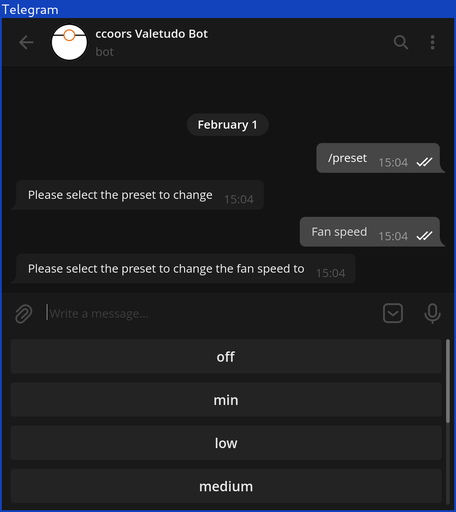A Telegram Bot for Valetudo
This bot allows controlling a Valetudo instance via Telegram. It runs directly on the vacuum robot, using the runtime provided by Valetudo.
Please note that this bot is in its very early stages of development and is targeted at more technically inclined users.
This bot uses the Valetudo HTTP-API v2. Support for MQTT is not (yet?) implemented.
 |
 |
|---|---|
 |
 |
 |
Installation is a bit complicated, due to how Telegram Bots work.
Create a Telegram Bot using Botfather. Remember the token. Start the bot
by adding it to your contacts and clicking the "Start" button.
Download the latest valegram-bot release to your robot. Run this command, adjusting v0.1.2 to the latest
release.
cd /data
wget -O valegram-bot.js https://github.com/ccoors/valegram-bot/releases/download/v0.1.2/valegram-bot.jsmkdir /mnt/data/valegram
cd /mnt/data/valegram
wget -O valegram-bot.js https://github.com/ccoors/valegram-bot/releases/download/v0.1.2/valegram-bot.jsStart the bot directly from the shell. Replace $$$BOT_TOKEN$$$ with the token obtained from BotFather earlier.
PKG_EXECPATH=PKG_INVOKE_NODEJS VALEGRAM_BOT_TOKEN="$$$BOT_TOKEN$$$" ./valetudo valegram-bot.jsPKG_EXECPATH=PKG_INVOKE_NODEJS VALEGRAM_BOT_TOKEN="$$$BOT_TOKEN$$$" /usr/local/bin/valetudo /mnt/data/valegram/valegram-bot.jsThe bot needs to know which chats to respond to - otherwise everybody could control your robot. You can use
the /chat_id command in Telegram to get your chat id (eg. 104325692).
Try it out!
PKG_EXECPATH=PKG_INVOKE_NODEJS VALEGRAM_BOT_TOKEN="$$$BOT_TOKEN$$$" CHAT_IDS='[$$$CHAT_ID$$$]' ./valetudo valegram-bot.jsPKG_EXECPATH=PKG_INVOKE_NODEJS VALEGRAM_BOT_TOKEN="$$$BOT_TOKEN$$$" CHAT_IDS='[$$$CHAT_ID$$$]' /usr/local/bin/valetudo /mnt/data/valegram/valegram-bot.jsStop the bot (CTRL+C) and add it to your autostart script (/data/_root_postboot.sh on Dreame). I suggest extending the
final if-block like this (replace $$$CHAT_ID$$$ with your chat id):
if [[ -f /data/valetudo ]]; then
VALETUDO_CONFIG_PATH=/data/valetudo_config.json /data/valetudo > /dev/null 2>&1 &
sleep 30
PKG_EXECPATH=PKG_INVOKE_NODEJS VALEGRAM_BOT_TOKEN="$$$BOT_TOKEN$$$" CHAT_IDS='[$$$CHAT_ID$$$]' /data/valetudo /data/valegram-bot.js > /tmp/valegram-log.log 2>&1 &
fi
Alternatively, create a wrapper shell-script, which may prove more to be maintainable in the future.
Stop the bot (CTRL+C) and create an autostart script:
cd /etc/init
touch S999valegram
chmod +x S999valegramEdit the script with nano nano S999valegram and add the folowing script (replace $$$BOT_TOKEN$$$ and $$$CHAT_ID$$$).
#!/bin/sh
export PKG_EXECPATH=PKG_INVOKE_NODEJS
export VALEGRAM_BOT_TOKEN="$$$BOT_TOKEN$$$"
export CHAT_IDS='[$$$CHAT_ID$$$]'
load() {
echo "starting valegram, process will be ready in about 35 seconds."
start-stop-daemon -S -b -q -m -p /var/run/valegram.pid -x bash -- -c 'sleep 30; /usr/local/bin/valetudo /mnt/data/valegram/valegram-bot.js'
}
unload() {
echo "stopping valegram"
start-stop-daemon -K -q -p /var/run/valegram.pid
}
case "$1" in
start)
load
;;
stop)
unload
;;
restart)
unload
load
;;
*)
echo "$0 <start/stop/restart>"
;;
esacYou can try starting the valegram service (startup is delayed by 30 seconds):
/etc/init/S999valegram start
If everything works, valegram should start on startup of your robot.
Run the /help command in Telegram. Remove the / from each line, use /setcommands in BotFather and set the command block.
valegram-bot is configured through environment variables.
| Variable | Description | Default |
|---|---|---|
VALEGRAM_BOT_TOKEN |
The bot token | "" |
VALETUDO_URL |
The URL Valetudo can be reached under | http://localhost/ |
VALETUDO_HTTP_TIMEOUT |
The timeout for HTTP requests to Valetudo | 10_000 |
VALETUDO_AUTH_USERNAME |
The username for HTTP-Basic-Auth | "" |
VALETUDO_AUTH_PASSWORD |
The password for HTTP-Basic-Auth | "" |
CHAT_IDS |
The chat ids valegram-bot should respond to. JSON array of numbers. | [] |
ICBINV_URL |
If you run ICBINV with an enabled webserver, set the URL to ICBINV_URL=http://ICBINV_HOST:3000/api/map/image to enable the /map command |
"" |